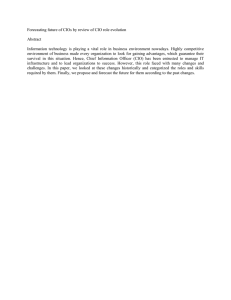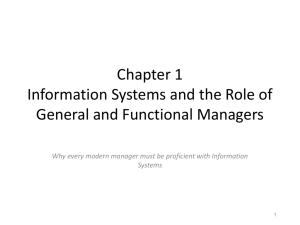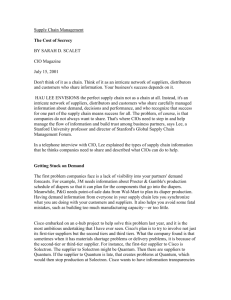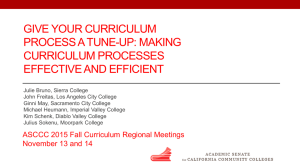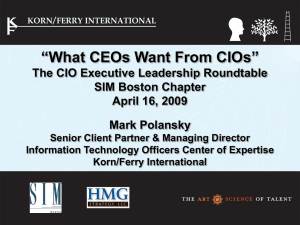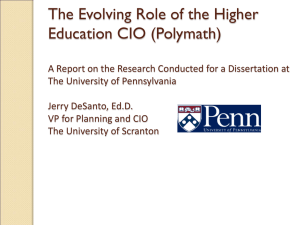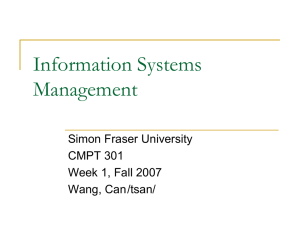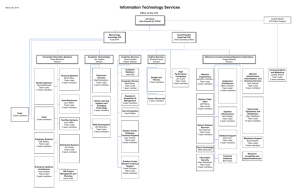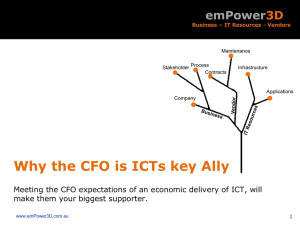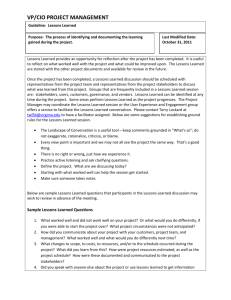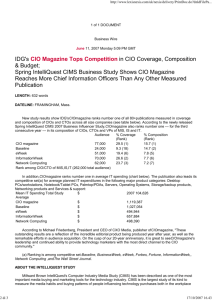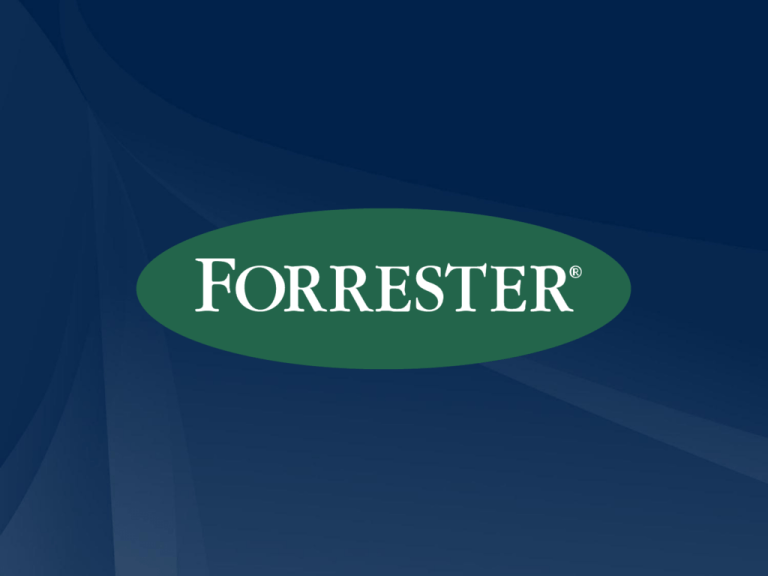
Structuring The IT Organization
For The Future
Jim Scanlon
Senior Advisor
Forrester Research
May 13, 2008
Theme
CIOs are proactively
structuring their IT
organizations for the future,
embracing internal and
external forces, using them
to their advantage
Agenda
• Review the internal and external forces of change
that impact the IT organization
• Discuss the critical skills and structure for the IT
organization of the future
• Highlight the models and best practices for
structuring the IT organization for the future
The internal forces of change
Source: Heather Smith and James McKeen, “IT in 2010: the next frontier,” MIS Quarterly Executive, Vol. 5, No. 3, 2006
IT organizations’ external pressures have also
mounted
CIOs are restructuring to survive and thrive
Key drivers for restructuring
Critical skills of the IT
organization of the future
Domains of expertise
Compliance/security/risk mgmt.
Customer experience
Enterprise architecture
Relationship management
Applications development
Infrastructure and operations
IT marketing and communication
Vendor and sourcing mgmt.
1st tier
(rated a 5, “very important”)
Process management
Program management
Innovation/emerging technologies
Information management
2nd tier
(rated a 4, “important”)
The skills needed for an IT employee in the future IT
organization
IT structure
models and best practices
Business’ expectations and industry-specific
constraints determine the firm’s mission for IT
Partner Player
►IT organizations expected to create unique
and competitive solutions with customers,
Partner
suppliers, and internal users — plus, being a
Player
Trusted Supplier.
Trusted
Supplier
Solid Utility
Trusted Supplier
►IT organizations expected to deliver app
projects on time and on budget, based
on operating units’ requirements and
priorities — plus, being a Solid Utility.
Solid Utility:
►IT organizations expected to provide
cost-effective, dial-tone reliability with
transparent, constantly declining
costs.
Business expectations — not CIOs’ ambitions —
determine what an IT shop’s archetype should be
How the
enterprise
views the . . .
Solid Utility
Role of
technology
Technology is critical for
Infrastructure technology
enterprise functions like
is critical; app criticality
sales, marketing, and
varies by BU
finance
Technology is integral
to products and
services — and go-tomarket strategies
Technology
requirements
What’s standard for
infrastructure excellence
What’s standard for
functional excellence
What’s unique for
competitive advantage
Visibility into
IT
Financial
Functional department
management
Executive team
Trusted Supplier
Partner Player
Mission of IT
“Keep the lights on”
“Do projects right”
Varies by industry, like,
“Get the package there
overnight”
CIO’s role
Operational — contain
costs
Service-oriented,
ensuring successful
delivery
Business partner, tied
closely to enterprise
strategy
Three IT organizational design models
IT-services-driven
organizational
model
Supply-anddemand-driven
organizational
model
Business-process
driven
organizational
model
IT-services-driven organizational model
CIOs choose this model to:
• Position the IT
organization as a provider
of superior IT services and
value-add
• Focus on creating a
catalog of products and
services with SLAs
• Act as a technology
provider to the business,
one that is competitive with
outside providers
Key supporting roles:
Account/relationship manager
IT-services-driven
organizational
model
Product manager
Customer service director
Communications director
Case Study: Joe Lacik, senior vice president,
Information Services, Aviall
Position the IT organization as a service provider
• CIO Group member built his IT organization
from scratch in 2000 to 100 employees. Picked
a model to match the business’s values and the
core value was service.
• Key Actions:
» Create a “profile” for an IT employee who embodies
the service mindset and only hire those that fit within
it
» Reward IT employees by the level of customer
satisfaction, not by level of technical skills
Joe Lacik, senior vice president, Information
Services, Aviall
Supply-and-demand-driven organizational model
CIOs choose this model to:
• Balance business’
demand with the supply
and delivery of quality
services
• Manage IT supply
effectively, whether it
comes from internal or
external sources
• Improve project
prioritization and execution
Key supporting roles:
Supply-anddemand-driven
organizational
model
Resource manager
Sourcing/vendor manager
Demand manager
Case Study: Karl Salnoske, VP and CIO, Schering-Plough
Structure The IT Organization To Manage Supply And Demand
• CIO transformed the IT organization from a utility into a
strategic asset. Centralized the structure in support of
corporate philosophy to operate as a global company.
• Key Actions:
» Create a “critical mass” of IT talent, while maintaining a
customer focus
» Hire business partners, strategists, and problem-solvers for
demand organization
» Give customer relationship managers and architects elevated
responsibility
Case Study: Karl Salnoske, VP and CIO, Schering-Plough
Structure The IT Organization To Manage Supply And Demand
Business-process-driven organizational model
CIOs choose this model to:
• Position IT resources in
support of business
processes that span
vertical business units
• Manage horizontal
processes in a matrixed
way to gain competitive
advantage through process
improvement
Key supporting roles:
Enterprise architect
Business-process
driven
organizational
model
Business process analyst
Process framework expert
Case study: Gail Farnsley, VP and CIO, Cummins
Realign IT around common business processes
• Evolve from “Darwin’s Islands” to a business
process model that will leverage process
efficiencies among the business units.
• Key actions:
» Assign responsibility for the development of crossbusiness unit functional IT strategies to IT leaders
» Create business process team to manage functional
portfolios
» Test new structure before implementing it
Case study: Gail Farnsley, VP and CIO, Cummins
Realign IT around common business processes
Best practices for structuring the IT organization
Summary
• CIOs are proactively structuring their IT organizations
for the future
• Adapting to internal and external forces
• Building the skills and structure needed for the future
• And improving IT-business alignment and their
strategic impact on the business
Download these slides and
complimentary research at:
www.forrester.com/simsf
Thank you
Jim Scanlon
+1.650.581.3856
jscanlon@forrester.com
www.forrester.com
Entire contents © 2007 Forrester Research, Inc. All rights reserved.

